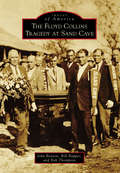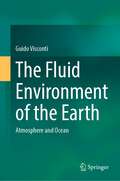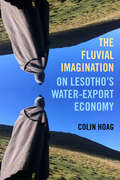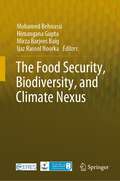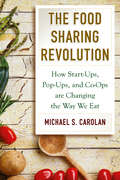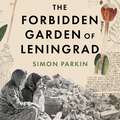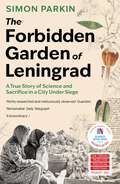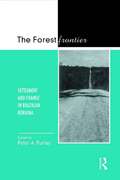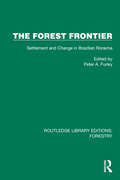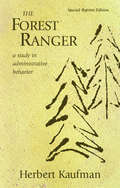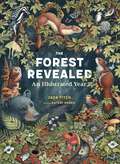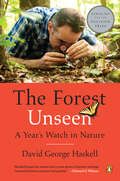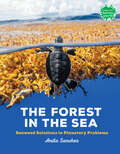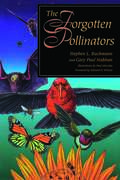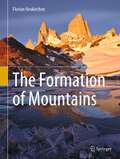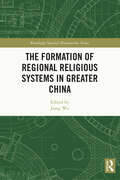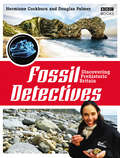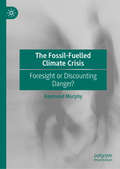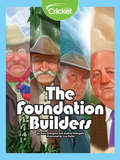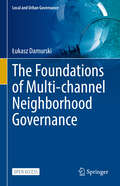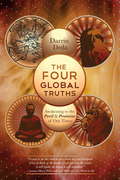- Table View
- List View
The Floyd Collins Tragedy at Sand Cave (Images of America)
by John Benton Bob Thompson Bill NapperFloyd Collins is perhaps the most famous person you have probably never heard of. Collins was a Kentucky cave explorer who was trapped for more than two weeks during the winter of 1925 in a cave located within the boundaries of what is now Mammoth Cave National Park. Collins had no fear of exploring the most difficult cave passages, and few people could match his persistence and endurance. The story of Floyd Collins becoming trapped, then buried alive, and ultimately dying alone in a cave held a powerful grip on the hearts and minds of people the world over. The resulting media coverage put Mammoth Cave on the map and helped usher the actual designation of Mammoth Cave as a national park. His explorations laid the foundation for others to later discover that Mammoth Cave was the longest cave in the world.
The Fluid Environment of the Earth: Atmosphere and Ocean
by Guido ViscontiThe book is conceived at two levels. An introductory one intended for undergraduate and/or environmental studies students and the other (in the appendix) for advanced students (graduate). The book is different from others on the same subject which are either too descriptive or too much specialized. Beside there are large sections on biogeochemistry not usually found in other textbooks. Whenever possible an approach based on entropy considerations is introduced. The book includes a quite classical introduction to the thermodynamics of ocean and atmosphere, then the circulation of the ocean and atmosphere, the connection climate-chemistry with main emphasis on the carbon dioxide problem. The chemistry is also considered in connection with the polluted atmosphere and ocean and particulate in the atmosphere . A chapter is dedicated to the biogeochemical cycles which are solved both with the integration of a system of equations or matrix algebra. An original chapter is dedicated to sea-atmosphere interactions which includes the monsoons meteorology, hurricanes and the ENSO phenomena. Finally a concise description of the fluid environments in the Solar System is given.
The Fluvial Imagination: On Lesotho's Water-Export Economy (Critical Environments: Nature, Science, and Politics #12)
by Colin HoagA free open access ebook is available upon publication. Learn more at www.luminosoa.org. Landlocked and surrounded by South Africa on all sides, the mountain kingdom of Lesotho became the world's first "water-exporting country" when it signed a 1986 treaty with its powerful neighbor. An elaborate network of dams and tunnels now carries water to Johannesburg, the subcontinent's water-stressed economic epicenter. Hopes that receipts from water sales could improve Lesotho's fortunes, however, have clashed with fears that soil erosion from overgrazing livestock could fill its reservoirs with sediment. In this wide-ranging and deeply researched book, Colin Hoag shows how producing water commodities incites a fluvial imagination. Engineering water security for urban South Africa draws attention ever further into Lesotho's rural upstream catchments: from reservoirs to the soils and vegetation above them, and even to the social lives of herders at remote livestock posts. As we enter our planet's water-export era, Lesotho exposes the possibilities and perils ahead.
The Food Security, Biodiversity, and Climate Nexus
by Mohamed Behnassi Himangana Gupta Mirza Barjees Baig Ijaz Rasool NoorkaThis volume is the outcome of an international cooperation between 73 scientists, experts, and practitioners from many countries, disciplines, and professional areas. As a part of a series of CERES publications, the volume attempts to contribute to the scientific debate about the food–biodiversity–climate nexus by developing a comprehensive region-specific and broader global understanding of the linkages between these areas, especially in the context of Global South. Instead of providing only modern science-based solutions for the nexus related challenges, the volume covers case studies that present mixed solutions, offering the use of traditional ecological knowledge in combination with modern science for both resilience and sustainability. This is increasingly instrumental in shaping the needed response options regarding the economic, social, and environmental future of the world. Based on a multi-regional and cross-sectoral analysis, the approach consists of: assessing the different natural and anthropogenic factors currently affecting ecosystems and their services, especially the impacts of climate change; highlighting the different linkages between the state of biodiversity and food systems in many contexts and scales; and exploring the various response mechanisms to effectively manage the implications of such linkages. Most chapters provide inputs for future relevant research and policy agendas.
The Food Sharing Revolution: How Start-Ups, Pop-Ups, and Co-Ops are Changing the Way We Eat
by Michael S. CarolanMarvin is a contract hog farmer in Iowa. He owns his land, his barn, his tractor, and his animal crates. He has seen profits drop steadily for the last twenty years and feels trapped. Josh is a dairy farmer on a cooperative in Massachusetts. He doesn't own his cows, his land, his seed, or even all of his equipment. Josh has a healthy income and feels like he's made it.In The Food Sharing Revolution, Michael Carolan tells the stories of traditional producers like Marvin, who are being squeezed by big agribusiness, and entrepreneurs like Josh, who are bucking the corporate food system. The difference is Josh has eschewed the burdens of individual ownership and is tapping into the sharing economy.Josh and many others are sharing tractors, seeds, kitchen space, their homes, and their cultures. They are business owners like Dorothy, who opened her bakery with the help of a no-interest, crowd-sourced loan. They are chefs like Camilla, who introduces diners to her native Colombian cuisine through peer-to-peer meal sharing. Their success is not only good for aspiring producers, but for everyone who wants an alternative to monocrops and processed foods.The key to successful sharing, Carolan shows, is actually sharing. He warns that food, just like taxis or hotels, can be co-opted by moneyed interests. But when collaboration is genuine, the sharing economy can offer both producers and eaters freedom, even sovereignty. The result is a healthier, more sustainable, and more ethical way to eat.
The Forbidden Garden of Leningrad: A True Story of Science and Sacrifice in a City under Siege
by Simon ParkinFrom the winner of the 2023 Wingate Literary Prize comes a fascinating and moving untold story of the Leningrad scientists who risked everything for the future of humanity"An astonishing story brilliantly told... It is as moving as it is gripping to read"Jonathan Dimbleby, author of Endgame: 1944"A gripping, original and important story of courage and science in wartime" Roland Philipps, author of A Spy Named OrphanIn the summer of 1941, German troops surrounded the Russian city of Leningrad - now St Petersburg - and began the longest blockade in recorded history. By the most conservative estimates, the siege would claim the lives of three-quarters of a million people. Most died of starvation.At the centre of the embattled city stood a converted palace that housed the greatest living plant library ever amassed - the world's first seed bank. After attempts to evacuate the collection failed, and as supplies dwindled, the scientists responsible faced a terrible decision: should they distribute the specimens to the starving population, or preserve them in the hope that they held the key to ending global famine?Drawing on previously unseen sources, The Forbidden Garden tells the remarkable and moving story of the botanists who remained at the Plant Institute during the darkest days of the siege, risking their lives in the name of science."A beautifully-written account of one of the most extraordinary and little-known episodes of the Second World War -- a scientific feat and act of collective self-sacrifice the consequences of which continue to be felt today."Adam Higginbotham, author of Challenger
The Forbidden Garden of Leningrad: A True Story of Science and Sacrifice in a City under Siege
by Simon ParkinFrom the winner of the 2023 Wingate Literary Prize comes a fascinating and moving untold story of the Leningrad scientists who risked everything for the future of humanity"An astonishing story brilliantly told... It is as moving as it is gripping to read"Jonathan Dimbleby, author of Endgame: 1944"A gripping, original and important story of courage and science in wartime" Roland Philipps, author of A Spy Named OrphanIn the summer of 1941, German troops surrounded the Russian city of Leningrad - now St Petersburg - and began the longest blockade in recorded history. By the most conservative estimates, the siege would claim the lives of three-quarters of a million people. Most died of starvation.At the centre of the embattled city stood a converted palace that housed the greatest living plant library ever amassed - the world's first seed bank. After attempts to evacuate the collection failed, and as supplies dwindled, the scientists responsible faced a terrible decision: should they distribute the specimens to the starving population, or preserve them in the hope that they held the key to ending global famine?Drawing on previously unseen sources, The Forbidden Garden tells the remarkable and moving story of the botanists who remained at the Plant Institute during the darkest days of the siege, risking their lives in the name of science."A beautifully-written account of one of the most extraordinary and little-known episodes of the Second World War -- a scientific feat and act of collective self-sacrifice the consequences of which continue to be felt today."Adam Higginbotham, author of Challenger
The Forest Certification Handbook
by Christopher UptonFrom forester to retailer, stakeholders in the industry are under increasing pressure to assure customers that their wood products have come from well managed, sustainable forests. The Forest Certification Handbook gives practical advice on developing, selecting and operating a certification programme which provides both market security and raises standards of forestry management. It provides a thorough analysis of all the issues surrounding certification, including the commercial benefits to be gained, the policy mechanisms required, the interpretation and implementation of forestry management standards, and the process of certification itself. Three unique directories give details of currently certified forests, international and national initiatives, and active certification programmes.
The Forest Frontier: Settlement and Change in Brazilian Roraima
by Edited by Peter A. FurleyDestructive patterns of Amazonian evolution are now infecting relatively untouched Northern Brazil - driven by the gold rush and demographic and economic forces from the South. The Forest Frontier assesses whether the Northern Amazonian States can avoid the same pressures and problems that affect the peoples and environments of the South. It examines the social and environmental nature of land development in Roraima, the most northerly of the Brazilian Amazonian states. Possessing most of the classic problems facing other States as well as containing a combination of political, cultural and environmental features, Roraima's development is at a frontier. Offering a critical assessment of the nature and pace of agricultural advance into Roraima, The Forest Frontier will provide a better understanding to plan for the inevitable development to come.
The Forest Frontier: Settlement and Change in Brazilian Roraima (Routledge Library Editions: Forestry)
by Peter A. FurleyOriginally published in 1994, this book analysed land developments, deforestation and pasture substitution, colonisation schemes and spontaneous settlement during the latter part of the 20th Century. In so doing, The Forest Frontier presents an overview of the intrinsic environmental and socio-economic resources of the Roraima, the most northerly of the Brazilian Amazon states. Roraima is of special environmental interest because of its extensive savannas and varied forests – the home of some of the largest and most diverse groups of indigenous Indians. This critical assessment of the nature and pace of agricultural advance into Roraima examines the range of strategies which have been proposed to cope with the inevitable development. With the conflict between preserving the natural environment and development still major issues for Brazil, this book remains as relevant now as when it was first published.
The Forest Ranger: A Study in Administrative Behavior
by Herbert KaufmanIt is the rare book that remains in print for nearly fifty years, earning wide acclaim as a classic. The Forest Ranger has been essential reading for generations of professionals and scholars in forestry, public administration, and organizational behavior who are interested in the administration of public lands and how the top managers of a large, dispersed organization with multiple objectives like the Forest Service shape the behavior of its field officers into a coherent, unified program. Published as a special reprint in conjunction with the 100th anniversary of the U.S. Forest Service, The Forest Ranger is as relevant and timely today as when it was first issued in 1960. In addition to the original text, this special reprint of The Forest Ranger includes two new forewords and an afterword that highlight how much we have learned from Herbert Kaufman. The first foreword, by Harold K. (Pete) Steen, former president of the Forest History Society, considers the book's impact on the forestry community and explains its continued relevance in light of changes in the culture and mission of today's Forest Service. The second, by Richard P. Nathan, co-director of the Rockefeller Institute of Government, considers the book's contribution to our understanding of administrative and organizational behavior. A new afterword by author Herbert Kaufman describes how his landmark study came into being and offers a candid assessment of how his theories about the agency's operations and its future have held up over time. In 1960, the Forest Service had a welldeserved reputation for excellence, and The Forest Ranger was a seminal analysis of the how's and why's of its success. Kaufman also warned, however, that an organization so unified and well adapted to its environment would have difficulties navigating social change. He was right in his concerns: The environmental, civil rights, and women's movements have all presented challenges to the character and purpose of the Forest Service, ultimately changing the organization in subtle and not-so-subtle ways. Now, as then, The Forest Ranger is a striking and prescient case study of how a complex organization operates and evolves over time.
The Forest Revealed: An Illustrated Year
by Jada Fitch Kateri KosekDiscover the amazing, fun diversity of life in the northern forest through 12 vivid paintings, each with a numbered key to search for and identify the animals, plants, insects and fungi pictured. Each of artist Jada Fitch's twelve stunning paintings represents the forest during one month of the year, featuring an array of animals, plants, insects, fungi, and other creatures common during those weeks. Opposite each painting is a list of all the species depicted, with corresponding numbers in the art, creating a search-and-find experience that will keep readers of all ages discovering more every time they look. Then turn the page to zoom in and see these creatures in even more gorgeous detail. This wondrous array of wildlife is brought further to life by writer and naturalist Kateri Kosek, who uncovers the many hidden stories and fun facts about the flora and fauna that make up the forest ecosystem, inviting you to look more closely at nature all around you. This publication conforms to the EPUB Accessibility specification at WCAG 2.0 Level AA.
The Forest Unseen
by David George HaskellA 2013 Pulitzer Prize Finalist for General Nonfiction Winner of the 2013 Best Book Award from the National Academies A Finalist for the PEN/E.O. Wilson Literary Science Writing Award Winner of the National Outdoor Book Award Winner of the Reed Award from the Southern Environmental Law Center A biologist reveals the secret world hidden in a single square meter of forest Written with remarkable grace and empathy, The Forest Unseen is a grand tour of nature in all its profundity. Biologist David George Haskell uses a one-square-meter patch of old-growth Tennessee forest as a window onto the entire natural world. Visiting it almost daily for one year to trace nature's path through the seasons, he brings the forest and its inhabitants to vivid life. Beginning with simple observations--a salamander scuttling across the leaf litter, the first blossom of spring wildflowers--Haskell spins a brilliant web of biology, ecology, and poetry, explaining the science binding together ecosystems that have cycled for thousands--sometimes millions--of years.
The Forest in the Sea: Seaweed Solutions to Planetary Problems (Books for a Better Earth)
by Anita SanchezMeet an unlikely climate change hero: the wet, slimy stuff known as seaweed.Imagine forests where you can float weightlessly among schools of fish. Huge green pastures where sea turtles graze. Forests that capture carbon from seawater and breathe out oxygen. The answers to many of our planet&’s problems may lie underwater, in these forests of seaweed.Celebrated nonfiction author Anita Sanchez takes readers on a tour of seaweed forests, from the Sargasso Sea to seaweed patches off Prince Edward Island, to explore how seaweed supports marine ecosystems and plays a big role in climate change solutions. From reducing methane emissions to advances in biofuels, medicines, and more, seaweed science is at the forefront of innovation.Written with beauty and wonder, The Forest in the Sea encourages readers to think outside the box when it comes to climate change. Back matter includes recipes, activities, ways to identify and help protect seaweed, and more.Books for a Better Earth are designed to inspire children to become active, knowledgeable participants in caring for the planet they live on.Books for a Better Earth are designed to inspire children to become active, knowledgeable participants in caring for the planet they live on.A Junior Library Guild Gold Standard Selection
The Forgotten Pollinators: Dynamics And Restoration Of Abandoned Farmland
by Gary Paul Nabhan Paul Mirocha Stephen L. BuchmannConsider this: Without interaction between animals and flowering plants, the seeds and fruits that make up nearly eighty percent of the human diet would not exist.In The Forgotten Pollinators, Stephen L. Buchmann, one of the world's leading authorities on bees and pollination, and Gary Paul Nabhan, award-winning writer and renowned crop ecologist, explore the vital but little-appreciated relationship between plants and the animals they depend on for reproduction -- bees, beetles, butterflies, hummingbirds, moths, bats, and countless other animals, some widely recognized and other almost unknown.Scenes from around the globe -- examining island flora and fauna on the Galapagos, counting bees in the Panamanian rain forest, witnessing an ancient honey-hunting ritual in Malaysia -- bring to life the hidden relationships between plants and animals, and demonstrate the ways in which human society affects and is affected by those relationships. Buchmann and Nabhan combine vignettes from the field with expository discussions of ecology, botany, and crop science to present a lively and fascinating account of the ecological and cultural context of plant-pollinator relationships.More than any other natural process, plant-pollinator relationships offer vivid examples of the connections between endangered species and threatened habitats. The authors explain how human-induced changes in pollinator populations -- caused by overuse of chemical pesticides, unbridled development, and conversion of natural areas into monocultural cropland-can have a ripple effect on disparate species, ultimately leading to a "cascade of linked extinctions."
The Formation of Mountains
by Florian NeukirchenMountains as we know them were formed by a wide range of processes. This vivid introduction explains the course of orogeny (mountain formation) and the resulting structures, the cycles of plate tectonics and the evolution of landforms. It also presents surprising findings from the latest research. Popular travel destinations are described in detail – ideal when preparing for a trip – while a wealth of photos and graphics illustrate the text. Why are mountains as tall as they are? How does high-pressure rock come to the surface? Is there feedback between tectonics and the climate? How can mountains form without continental collision, far away from any plate boundaries? And how do we know all this? These and many other questions will be answered.
The Formation of Regional Religious Systems in Greater China (Routledge Spatial Humanities Series)
by Jiang WuThe rise of Spatial Humanities has spurred a digital revolution in the field of Chinese studies, especially in the study of religion. Based on years of data compilation and analysis of religious sites, this book explores the formation of Regional Religious Systems (RRS) in Greater China in unprecedented scope and depth. It addresses quantitatively the enduring historical and contemporary issues of China’s deep-rooted regionalism and spatially variegated cultural and religious landscape. A range of topics are explored: theoretical discussions of the concept of RRS; case studies of regional and local religious institutions; the formation of local cults and pilgrimage network; and the spread of religious networks to overseas Chinese communities and the Bon religion in Tibet. The book also considers long-standing challenges of researching with spatial data for humanities and social science research, such as data collection, integration, spatial analysis, and map creation. This book will be of interest to students and scholars in Religious Studies, Cultural Studies, Chinese Studies, Digital Humanities, Human Geography and Sociology.
The Formation of Vegetable Mould Through The Action of Worms - With Observations on Their Habits
by Charles DarwinThe Fossil Detectives: Discovering Prehistoric Britain
by Douglas Palmer Hermione CockburnFossils provide us with a tantalizing glimpse of Britain's prehistoric past and hold the key to unlocking the secrets of life's history and evolution. Since the appearance of primitive organisms in Britain more than a billion years ago, oceans, deserts, swamps and vast mountains have come and gone in our corner of western Europe; forests of long-extinct trees, flowers and grasses have covered the land, and dinosaurs and other strange creatures have roamed across it. How do we know? The evidence is all around us - in the rocks and fossils that lie beneath the landscape.In this highly informative and practical book, which accompanies the BBC series, presenter Hermione Cockburn and renowned palaeontologist Douglas Palmer take an in-depth look at the most exciting fossil stories from around the country. When and why were dinosaur fossils first discovered in Britain? How was the biggest fish ever to have swum in the sea unearthed near Peterborough? What do modern medical techniques have to offer fossil hunters?Packed with colour photographs and illustrations, Fossils Detectives is full of surprising facts and features. And for those who want to try their hand at some fossil detecting of their own, the book includes an extensive regional gazetteer of fossil-hunting sites and places to visit, and guidance on identifying your fossil finds.Get ready for some time travel around Britain, with the Fossil Detectives!
The Fossil-Fuelled Climate Crisis: Foresight or Discounting Danger?
by Raymond MurphyThis book analyses the threat posed by the continued use of fossil fuels. By utilizing Elizabeth Shove’s social practices approach and Murphy’s own social closure framework, the book examines the accelerating treadmill of carbon-polluting practices. It incorporates externalities theory to investigate how the full cost of fossil fuels is paid by others rather than users, and to demonstrate that the environmental commons is a medium for conveying intergenerational monopolisation and exclusion in the Anthropocene. Murphy uncovers a pattern of opposition to change when exploiting valuable but dangerous resources. He argues that a new faith in mastering nature is emerging as a belief in just-in-time technological solutions to circumvent having to change fossil-fuelled practices.The book then moves on to assess proposed solutions, including Beck’s staging of risk and his hypothesis that the anticipation of global catastrophe will incite emancipation. It proposes a novel approach to enhancing foresight and avoid incubating disaster. It will appeal to readers interested in an original social science analysis of this creeping crisis and its resolution.
The Foundation Builders
by Gina DeAngelisLearn about America's founding conservationists: Theodore Roosevelt, Gifford Pinchot, Stephen T. Mather, Hugh Hammond Bennett.
The Foundations of Multi-channel Neighborhood Governance (Local and Urban Governance)
by Łukasz DamurskiThe book presents various aspects of the current urban development in the context of the recent rapid growth of the ICT sector. It focuses on the local scale, in line with the notion that the neighborhood is the fundamental component of any urban area. Beginning with a critical overview of the urban governance paradigms, through a careful analysis of the multifaceted relationships between the Internet and the urban functions, followed by a description of selected approaches to local urban spatial policy, it concludes with a concept of multi-channel neighborhood governance (MCNG). The key observation is that the accelerating virtualization of urban life has profound consequences for the spatial, social, and economic structures of cities. At the local level, it is changing the functional profile of neighborhoods, replacing some traditional on-site local services with online ones, reducing (or even eliminating) the need for face-to-face social interaction, rejoining work and home roles, and modifying the spatial behaviors of residents. All of this calls for a prompt response from the neighborhood governance, which should include the nonspatial (online) components of contemporary urban lifestyles. The book searches for an alternative to conventional planning, capable of addressing the virtualization of different urban functions at the neighborhood level and providing satisfactory solutions for shaping an optimal balance between online and offline environments. The study defines a comprehensive method for the management of essential services in urban neighborhoods, with special attention to the integration of online and offline channels. The MCNG concept includes a list of recommendations for urban policy practitioners on how to deal with digital conversion, how to manage land use, how to stimulate entrepreneurship, and how to improve quality of life.
The Four Global Truths
by Darrin DrdaWith the planet increasingly threatened with catastrophe and perhaps even collapse, many seekers are looking to past, proven models to create meaningful change in their lives. One such model is Buddhism's Four Noble Truths: the reality of suffering, the root cause of suffering, the end of suffering, and the path to the end of suffering. This fresh, timely book taps and modifies that ancient wisdom to address the pressing environmental and spiritual crises facing us. In The Four Global Truths, author Darrin Drda contends that as global temperatures rise and natural systems decline, humanity is forced to confront the destructiveness of unfettered material progress and mechanistic thinking. He posits a more enlightened worldview that honors the interdependence of all forms of life and aspects of reality, a concept increasingly see as a practical and compassionate approach to averting disaster. Writing in a warm, open style recalling that of Eckhart Tolle in The New Earth, Drda integrates elements of Western philosophy, transpersonal psychology, deep ecology, modern cosmology, and quantum physics to get at the heart of worldwide ecological suffering. In the process he encourages a responsible and joyful--and ultimately healing--participation in this critical moment in life.About the Imprint: EVOLVER EDITIONS promotes a new counterculture that recognizes humanity's visionary potential and takes tangible, pragmatic steps to realize it. EVOLVER EDITIONS explores the dynamics of personal, collective, and global change from a wide range of perspectives. EVOLVER EDITIONS is an imprint of North Atlantic Books and is produced in collaboration with Evolver, LLC.From the Trade Paperback edition.
The Fourth Industrial Revolution and Its Impact on Ethics: Solving the Challenges of the Agenda 2030 (Sustainable Finance)
by Karen Wendt Katharina MillerThis book tackles the ethical problems of the “Fourth Industrial Revolution” (4IR) and offers readers an overview of the ethical challenges connected to Artificial Intelligence (AI), encryption and the finance industry. It specifically focuses on the situation of females in these industries, from women lawyers, judges, attorneys-at-law, investors and bankers, to portfolio managers, solicitors and civil servants. As the 4IR is more than “just” a technology-driven transformation, this book is a call to policymakers and business leaders to harness new technologies in order to create a more inclusive, human-centered future. It offers many practical cases of proactive change agents, and offers solutions to the ethical challenges in connection with implementing revolutionary disruptive products that often eliminate the intermediary. In addition, the book addresses sustainable finance in startups. In this context, education, training, agility and life-long learning in financial literacy are some of the key solutions highlighted here. The respective contributors supply a diverse range of perspectives, so as to promote a multi-stakeholder approach.
The Fourth Part of the World: The Race to the Ends of the Earth, and the Epic Story of the Map That Gave America Its Name
by Toby Lester“Old maps lead you to strange and unexpected places, and none does so more ineluctably than the subject of this book: the giant, beguiling Waldseemüller world map of 1507.” So begins this remarkable story of the map that gave America its name.For millennia Europeans believed that the world consisted of three parts: Europe, Africa, and Asia. They drew the three continents in countless shapes and sizes on their maps, but occasionally they hinted at the existence of a "fourth part of the world," a mysterious, inaccessible place, separated from the rest by a vast expanse of ocean. It was a land of myth—until 1507, that is, when Martin Waldseemüller and Matthias Ringmann, two obscure scholars working in the mountains of eastern France, made it real. Columbus had died the year before convinced that he had sailed to Asia, but Waldseemüller and Ringmann, after reading about the Atlantic discoveries of Columbus’s contemporary Amerigo Vespucci, came to a startling conclusion: Vespucci had reached the fourth part of the world. To celebrate his achievement, Waldseemüller and Ringmann printed a huge map, for the first time showing the New World surrounded by water and distinct from Asia, and in Vespucci’s honor they gave this New World a name: America. The Fourth Part of the World is the story behind that map, a thrilling saga of geographical and intellectual exploration, full of outsize thinkers and voyages. Taking a kaleidoscopic approach, Toby Lester traces the origins of our modern worldview. His narrative sweeps across continents and centuries, zeroing in on different portions of the map to reveal strands of ancient legend, Biblical prophecy, classical learning, medieval exploration, imperial ambitions, and more. In Lester’s telling the map comes alive: Marco Polo and the early Christian missionaries trek across Central Asia and China; Europe’s early humanists travel to monastic libraries to recover ancient texts; Portuguese merchants round up the first West African slaves; Christopher Columbus and Amerigo Vespucci make their epic voyages of discovery; and finally, vitally, Nicholas Copernicus makes an appearance, deducing from the new geography shown on the Waldseemüller map that the earth could not lie at the center of the cosmos. The map literally altered humanity’s worldview. One thousand copies of the map were printed, yet only one remains. Discovered accidentally in 1901 in the library of a German castle it was bought in 2003 for the unprecedented sum of $10 million by the Library of Congress, where it is now on permanent public display. Lavishly illustrated with rare maps and diagrams, The Fourth Part of the World is the story of that map: the dazzling story of the geographical and intellectual journeys that have helped us decipher our world.
